 |
|
|
|
|||||
|
"...
we are on the threshold of a wireless revolution that will bring about
the increasing
convergence
of handheld devices and cellular phones, fundamentally altering the landscape"
PricewaterhouseCoopers"The biggest risk for organisations is believing that m-business opportunities are two to three years away. The pace with which businesses accept emerging technologies is accelerating. M-business is here today, and growing at a tremendous rate. "
| Handheld
devices and their role in the development of m-commerce |
|
The
results are below. The teams had two different approaches to this task.
Both results are useful to look at as a summary of wireless business and
m-commerce.
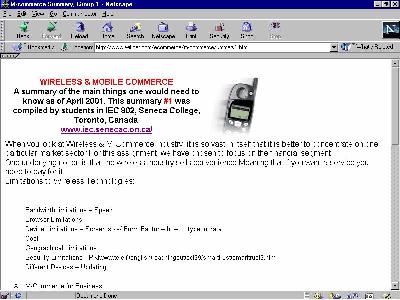 |
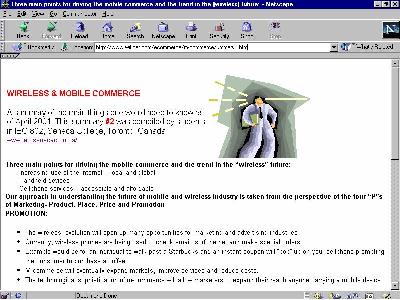 |
| . | Many of the professional
service firms, such as the accounting firms, law firms and management consulting
companies have addressed m-commerce in the PR material on their websites.
PricewaterhouseCoopers has a particularly good note on m-commerce since
it addresses the all encompassing aspects of its ffect on all business
categories.
WTGR "The convergence of wireless devices and the Internet is creating an important new channel to market — and the next wave of change across industries. Mobile business, or m-business as it has come to be known, will enable organisations in every industry to
from www.pwcglobal.com/extweb/mcs.nsf/docid/CD62BE635F4F749C852569DD0054B892 |
| Physical Limitations
of mobile devices, which need to be addressed before m-commerce can fully develop |
"Wireless
devices demand new models of information delivery and knowledge management,"
says Dr. Mark Chignell, CTO of Personification Inc. and head of the Interactive
Media Lab at the University of Toronto.
To allow more data to be viewed on the cellphone screen, Personification has developed 2 new technologies, namely TextSummary and PhoneSummary
|
| Physical Limitations
of mobile devices, which need to be addressed before m-commerce can fully develop |
Friedman notes that "the mobile market is growing quickly. Almost 30 per cent of Canadian households have at least one mobile phone. Sales of Internet-equipped phones are skyrocketing, while sales of PDAs are expected to double over last year's. There will soon be a vast, mobile Internet-equipped market hungry for content and services." however, despite this trend,
Friedman cautions "...You can't build much of a display into a mobile phone
without seriously compromising its portability, and unlike computers, most
mobile devices are designed to be operated with one hand.... The killer
app for the wireless Internet may not be traditional Web browsing at
|
| "... the shift to wireless" | April
2000
Macaluso quoted IDC's prediction
that by mid-2001 all digital cellular devices will be WAP-capable. IDC
was further quoted by Macaluso as saying that the shift to wireless is
driven in part by a growing trend on the part of phone service and other
providers to encourage customers to use the Web for customer service, bill
paying and account information. It is a logical extension for these companies
to prompt consumers to buy products and services over their Internet-ready
phones.
"the mobile market is growing
quickly. Almost 30 per cent of Canadian households have at least one mobile
phone.[Nov 2000] Sales of Internet-equipped phones are skyrocketing, while
sales of PDAs are expected to double over last year's. There will
soon be a vast, mobile Internet-equipped market hungry for content and
services."
|
| bandwidth
and handset design limitations WAP |
November
2000
"The mobile Internet market is growing quickly, but bandwidth and handset design limitations mean the wireless experience won't match the desktop experience any time soon."
"WAP has been hyped as the
be-all and end-all of the wireless Internet, but it's important to remember
that it's just one of many technologies,"
"... WAP has to overcome at least two substantial obstacles before it's really ready for prime time. The first problem is that for now, digital wireless connections are limited to a glacial 9600 bits per second — about a sixth the speed of a pokey 56k modem. It's unlikely that anyone would have much of an "Internet experience" at that pace. However, the bandwidth issues are sure to be solved in due course. A more serious question
is whether handheld, mobile wireless devices like cell phones and
personal digital assistants are even particularly well suited to online
browsing. You can't build much of a display into a mobile phone without
seriously compromising its portability, and unlike computers, most mobile
devices are designed to be operated with one hand."
|
| Q. Who are some
of the early players in the wireless web access developments? A - Phone companies
|
CNET had a story in December
1999 about Bell Atlantic's offering of wireless
http://news.cnet.com/news/0-1004-200-1431602.html?tag=st.ne.ni.rnbot.rn.ni  |
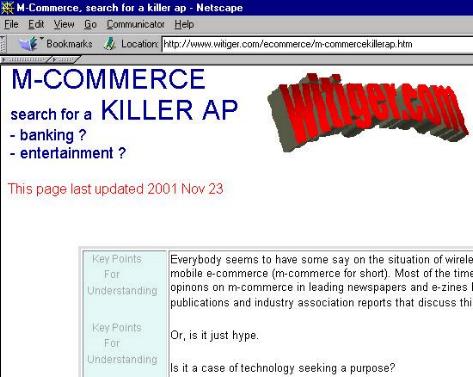
|
What does wireless mean to the human experience? What does
|
What is instant information? (WTGR)
|
.
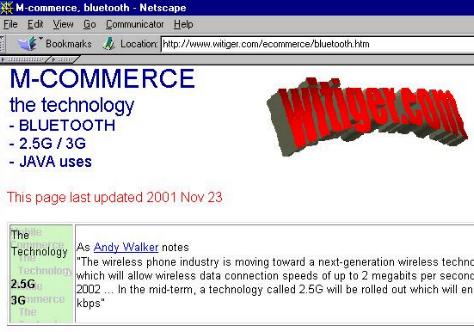
| m-commerce
but ... m-commerce
|
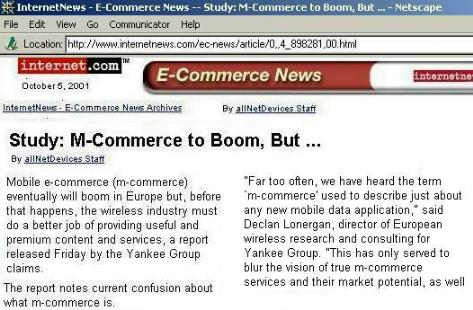
The article discusses how many people consider m-commerce in an un-focused way without breaking it down into subsets. The article suggests "m-commerce should be divided into three types, ...
This article was based on
a 2001 report titled
|
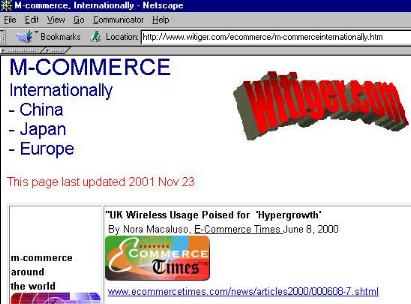
| Internet
needs space to grow Internet
Internet
|
"Ubiquitous Internet needs
space to grow"
Mr. Hamilton writes a long
article about the consequences of running out of IP addresses as more and
more devices and facilities are connected to the internet. He begins the
article by explaining the wide range of appliances and technologies that
could be connected tot he Net, which would require IP addresses in order
to be "contacted" and given commands.
"It's 2020 and, like electricity and running water, the Internet has come to power, and flows through every aspect of your life. Your personal computer and mobile phone aren't the only devices connected to the World Wide Web. Your microwave now surfs for recipes based on the ingredients in your cupboards. Your grocery orders are automatically placed online as food and drinks are taken from your fridge. Your dishwasher, before turning itself on, negotiates the cheapest energy rate for the day, thanks to a software agent known as a hydrobroker. Minivans. Air conditioners. Picture frames. Digital books. MP3 players. Palm computers. BlackBerry pagers. Smart cards. Pop machines. Motor boats.... They will all have a 24-hour, always-on connection to the Internet one day and, like the devices I mentioned above, they will all require Internet Protocol or IP addresses to identify them as unique online ``beings.'' Many experts suggest that the average person will need more than 100 IP addresses for his or her own use within the next 20 years. Herein lies the problem. The Internet, as it exists today, can't support 600 billion IP addresses. If we're lucky, it's capable of assigning 4.3 billion addresses. And if that's the case, we've already used up more than 60 per cent of the capacity, meaning we'll likely run out within the next few years. Can anybody say crisis? If you thought the Y2K bug threat was a major headache, then get ready for a migraine." |
| Internet
needs space to grow Internet
|
http://www.zdnet.com/intweek/stories/news/0,4164,2349342,00.html McGarvey explains, "The major shortcoming of the current version of IP, IPv4, is that it is running out of available IP addresses. Designed when the Internet was still a data-sharing network for research facilities and the military, IPv4 was given a 32-bit addressing scheme, which was capable of assigning a few billion unique addresses. IPv6, on the other hand, is beefed up with a 128-bit addressing scheme, which enables it to spawn many more billions of additional addresses." McGarvey notes the first
meeting of the IPv6 Forum, an international advocacy group dedicated to
advancing the next generation of the Internet Protocol (IP), was held in
Paris in October 1999.
|